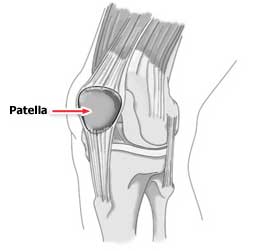
Runner's Knee (Patellofemoral Pain)
 Runners, jumpers, and other athletes such as skiers, cyclists, and soccer players put heavy stress on their knees. Runner's knee is a term used to refer to a number of medical conditions that cause pain around the front of the knee (patellofemoral pain).
Runners, jumpers, and other athletes such as skiers, cyclists, and soccer players put heavy stress on their knees. Runner's knee is a term used to refer to a number of medical conditions that cause pain around the front of the knee (patellofemoral pain).
Cause -
The knee is a complex structure and is very sensitive. A number of factors can contribute to runner's knee, including:
• Malalignment of the kneecap
• Complete or partial dislocation
• Injury
• Tightness, imbalance, or weakness of thigh muscles
• Flat feet
• Overuse
• Muscle imbalance
• Inadequate stretching.
• Kneecap is out of alignment.
Symptoms -
1. A dull, aching pain under or around the front of the kneecap (patella)
2. Pain occurs when walking up or down stairs, kneeling, squatting, and sitting with a bent knee for a long period of time.
Investigation -
x-ray, MRI ,CT Scan
Physiotherapy -
1. Cold packs or ice wrapped in a towel for short periods of time, several times a day.
2. Compression. Use simple knee sleeve with the kneecap cut out that fits snugly without causing pain.
3. Elevation. Keep the knee raised up higher than your heart
4. Modalities for pain relief.
5. Selective strengthening of the inner portion of the quadriceps muscle helps normalize the tracking of the patella.
6. Exercise with weights are avoided.
Prevention -
• Stay in shape:- Good general conditioning is important to controlling and preventing patella femoral pain. If you're too heavy, you may need to lose weight to avoid overstressing your knees.
• Stretch:- Before running or any other exercise, first do a 5-minute warm up, followed by stretching exercises. Stretching, particularly when lying prone, grab the ankle of the affected leg with one hand, and gently stretch the front of the knee.
• Increase training gradually:- Avoid sudden changes in the intensity of exercise. Increase force or duration of activities gradually.
• Use proper running gear:- Use running shoes with good shock absorption and quality construction. Be sure that shoes fit properly and are in good condition. If you have flat feet, you may need shoe inserts.
• Use proper running form:- Lean forward and keep your knees bent. Also, try to run on a clear, smooth, resilient, even, and reasonably soft surface. Never run straight down a steep hill. Walk down it, or run in a zigzag pattern.

